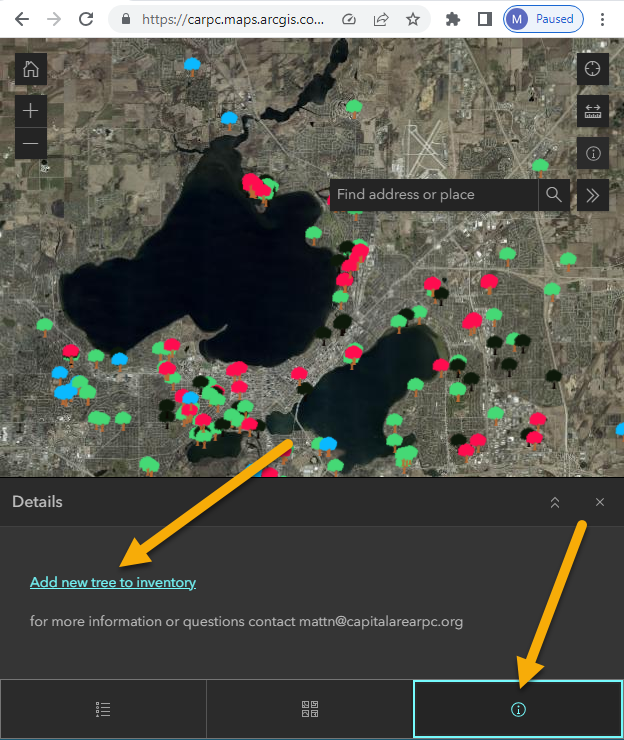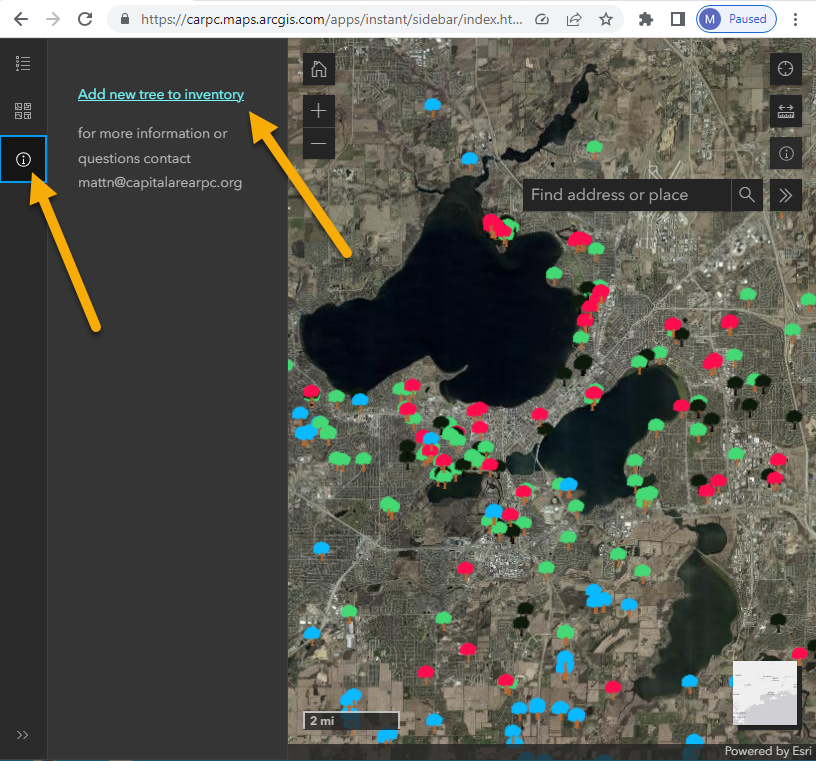We Need Your Help!
Visit the Interactive Heritage Oak Map to help us document historically significant oak trees in Dane County.
See instructions below on “How to Document Your Oak” or print and take these more detailed smartphone instructions before you head outside to add your oak to the project.
Please contact us if you have any questions!
Heritage Tree Seedling Information
Did you acquire and plant a Heritage Tree Seedling? If you haven’t already done so, please use this survey to let us know where and when you planted it.
If you haven’t got a seedling yet but are interested, please contact Matt Noone.
In 1976, local conservationist, preservationist, writer and assistant to the Wisconsin DNR secretary, Walter Scott, wrote, “Without question, the Madison area has a rich heritage in these venerable [oak] trees which are a living link with our past and challenge for the future.” Scott thereby initiated what is now called the Heritage Oak Project as a nod to both the previously dominant oak communities native to Dane County and the U.S. Bicentennial of our country’s independence. With an appeal to newspaper readers and the help of others, Scott attempted to identify as many 200 year or older oak trees as possible within an eight-mile radius of the Capitol.
Do you have a “Heritage Oak” in your yard?
Scott was successful in recording the measurements and locations of 443 oak trees on both public and private land. In 2001, arborist Bruce Allison (then of the Dane County Tree Board) traced Scott’s footsteps and determined that approximately half of these oaks remained alive while the other half had died of old age, been cut down for new development, or simply could not be located due to inaccurate previous location descriptions. While Allison took inventory of the oaks, he used GPS technology to log their exact location to make future work easier.
Today, the Tree Board, the Capital Area Regional Planning Commission (CARPC) and the University of Wisconsin State Cartographer’s Office are continuing Scott and Allison’s work by collaborating on a third round of inventorying what remains of the original list of oaks. They are now 250 years or older! Take a look at the Interactive Heritage Oak Map to see what we have already done.
We Need Your Help!
Scott also wrote, “How many [oaks] can we preserve for the Tricentennial in 2076? This would require a determined effort to keep them alive and well along with a willingness to allow for a place for them in an environment rapidly filling with asphalt and concrete developments.”
This is where you come in! There are still several specimens of once dominant oak trees scattered throughout city streets, backyards, parks, farmland and forests of Dane County. We are trying to add as many of these as we can to the inventory of the Heritage Oak Project.
We’re hoping that the general public (that’s you!) can help us in the following ways.
- You may have a Heritage Oak on your property that is already on Scott’s original list. If so, you can help us update the information we have for it.
- You may know about a Heritage Oak that is not in our inventory. If so, you can help us add it to the inventory.
- Spread the word! Tell your friends and neighbors about our project.
- Protect your oaks! Not only do these oaks provide environmental and economic benefits to the communities we live in, they are also living, historical artifacts.
How to Document Your Oak
Identify your oak tree!
Check out the pictures and info (Bur Oak, White Oak, Red Oak, Black Oak, Pin Oak) on the Morton Arboretum website. It’s a great resource!
Alternatively, the Wisconsin Urban Tree Key may help you compare the leaves of each species of oak side-by-side. The black and pin oak have very similar looking leaves, so they’re tricky to distinguish. In any case, if you can’t figure out what kind of oak you have, don’t worry about it. Take pictures of leaves, bark and the whole tree and email them to us. You will also be able to include a photo of your tree when you add your oak to the Heritage Oak Map.
Measure your tree!
At 4.5 feet from the base of the tree, local 200 year old white or bur oaks have a circumference of about 10 feet (~38″ diameter). Pin, black or red oak have a circumference of about 14 feet (~54″ diameter). At least, that’s what Walter Scott went with and we’re being consistent with that measure.
The key to measuring trees is that you don’t want to include any of the flaring on the tree trunk. At 4.5 feet above grade, the flaring from the base has tapered out. Also at that height, the flaring that occurs as the branches begin to extend from the trunk has not started. Remember, trees can have funny shapes and their diameters are often not perfect circles, so just try your best. For yet more information, check out these instructions from the Wisconsin DNR on how to measure the circumference of a tree.
Crowdsource! Add your oak measurements and photographs to our inventory using the Interactive Heritage Oak Map.
- If you are using a device with a small screen/window, click on the information icon at the bottom of the screen and then click on “Add new tree to inventory” and follow the prompts.
- If you want more specific instructions, check out our Smartphone Instructions for Adding Your Oak.

- If you are using a device with a large screen/window, click on the information icon at the left of the screen and then click on “Add new tree to inventory” and follow the prompts.

Handy Links
- How to measure your oak
- Protect your oak from oak wilt and spongy moth caterpillars!
- Certified arborist information
- Dane County Tree Board. Oaks Project. Our Oldest Oaks as a Living Heritage: A Quarter Century Update
By: R. Bruce Allison, Dane County Tree Board Member. (~2001) - Our Oldest Oaks – A Living Heritage. Walter Scott. The Capital Times. Madison, WI. August 11, 1976. p.53
- Dispatches from the Living Artifacts. Matt Noone. 9/12/2023. Learn about the Bag-A-Nut machine in this blog post about the adventures and process involved in collecting Heritage Oak acorns. They will be used to grow saplings and propagate the oaks’ lineage for another 200 years!
- Tree Canopy Preservation (Heritage Oak Project) Flyer (pdf)
- Register your Heritage Tree Seedling with this survey.
